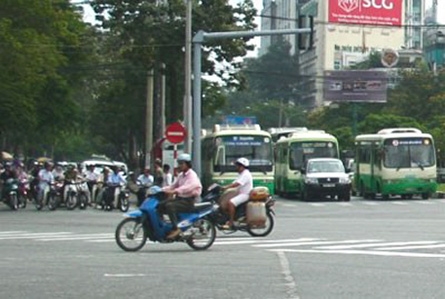A proposal that would allow buses to have their own lane would be a low-cost metro solution on the ground according to Prof. Pham Xuan Mai, from the Ho Chi Minh City University of Technology. The operation costs for the system were calculated to be quite low and this type of system could perform just as well as the metro system.
 |
| Buses that have their own lane will perform well and reduce the chance of getting stuck in traffic, especially during peak hours. |
BTR stands for Bus Rapid Transit, a term applied to a bus system that could operate on its own right-of-way. This is not a new type of transportation and in fact, it has been used in many countries all over the world. Its performance has been proved to be extremely effective. In a few countries, this type of bus system is often referred to as “fast busway” or “high quality busway”.
In a recent conference that took place on March 11, Mr. Le Trung Tinh, head of the Transport and Industry Management (Ho Chi Minh City Department of Transport and Communication) affirmed, “Developing BRT is not only a fast but also economical way to resolve traffic problems in Ho Chi Minh City.”
According to Mr. Tinh, the BRT system, in comparison with the Metro system (high-speed public transportation under the ground), introduces a lower cost solution due to its low construction cost, its ability to run smoothly along with other types of transportation, and the execution time for route construction (3 years for a complete system over the whole city, while it would take 10-20 years to construct one metro route).
Mr. Tinh also told DTiNews, “Investment cost for 1km BRT route would cost less than USD 5 million, while for 1km Metro route it would be USD 100 million.” The Metro route No1 from Ben Thanh to Suoi Tien with 19.7km would cost USD 2.5 billion. The operation cost for the metro system is also very high and in order to make it affordable for people, the local government would have to prepare large amounts of funding.
However, it is completely opposite with the BRT system. Professor Pham Xuan Mai said, “BRT is a transport system that has great passenger capacity, thus enables bus frequency and punctuation to be improved.”
Thus, in the Improving and Developing Ho Chi Minh City’s Bus Network research project by HCM City University of Technology, the research group suggested building 5 BRT routes in the period from 2011 – 2015, 2 more from 2016 – 2020, and then it will develop more quickly after the year 2020.
Development during period 2011 – 2020 would be slow due to limited infrastructure. After 2020, when land acquired for road construction has reached 17% of the natural land, the BRT system would add more routes.
However, the Ho Chi Minh City Department of Transportation and Communication is concerned about the project’s financial matters. The department had previously asked for support from the French Development Agency, World Bank, and International Association of Francophone Mayors, but until now they are still encountering many difficulties.
Not until 2009, the Rhône Council and French Development Agency finally sent two professionals of the Urban Forecast and Studies Centre (PADDI) to Vietnam to develop the project and they are currently looking at the construction project of one experimental BRT route for Ho Chi Minh City.
PADDI proposed building a pilot BRT route from Hung Vuong Avenue – Hong Bang – Ngo Gia Tu – Dien Bien Phu. According to research, this route meets all the requirements in terms of width and existing busy bus routes and could be easily replaced by new BRT bus routes.
The project is still in research phase. If the project is carried out now and goes through steps such as research and funding decisions, research project funds, making decisions, approval, investment, calling and construction,. It would take at least 3 years for the city to have its first BRT route.
Mr. Duong Hong Thanh, Vice General Manager of the city’s department of Transportation and Communication said, “This project has been mentioned in many conferences since 2005, but everything is still in a research phase. Hopefully it will soon be carried out.”

Leave your comment on this story